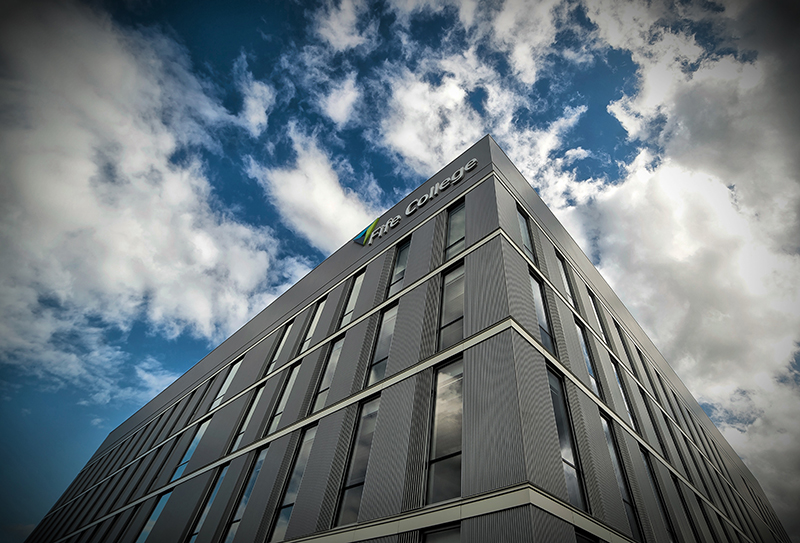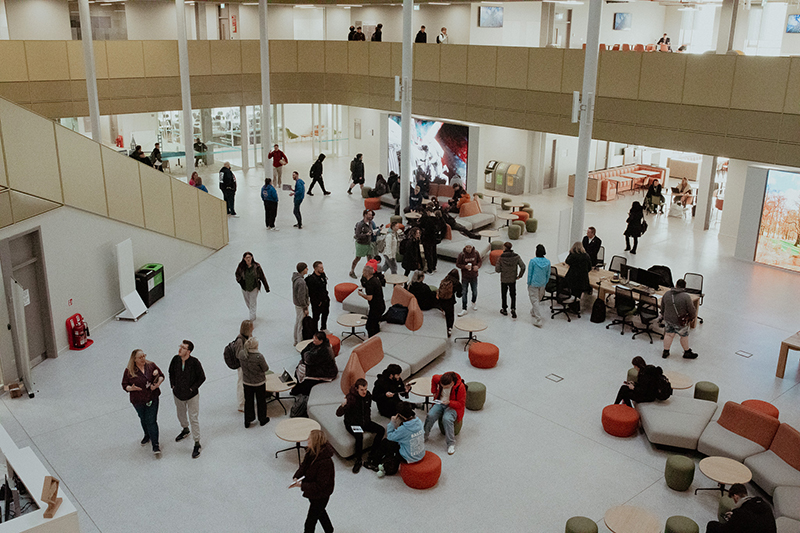
THE project director behind Balfour Beatty’s build of Scotland’s first net zero higher education building has challenged construction students to take inspiration from the facility’s innovative technical elements and drive Scotland’s environmental pursuits to the next level.
Project Scotland was given an exclusive tour of Fife College’s £155 million New Dunfermline City Campus building one week before it was officially opened to students. Setting a new benchmark for environmentally responsible design in Scotland, the campus is the largest of the Scottish Government’s pathfinder projects – which aims to use developments as test cases to trial innovative approaches before later scaling them across the country.
Built using a combination of cross-laminated timber (CLT), recycled steel, and precast concrete, key sustainability measures include the replacement of concrete floor slabs with CLT planks and green Delta Beams fabricated from 95% recycled steel. The combination of CLT and recycled steel enabled a lighter structural design – reducing the volume of concrete required for both the superstructure and foundations – which resulted in a reduction of 20% of the typical embodied carbon expected in a development of this size.

Innovative digital tools were used throughout construction, allowing the project team to use aggregated data filtered into user-friendly dashboards to make informed decisions based on real-time project information, as well as track progress and monitor resource allocation. A number of components were also manufactured off-site, including plantrooms and electrical switch rooms, roof modules, and vertical and horizontal risers – allowing for work that would take between two and three months to be delivered within a week.
“The younger generation is so interested in sustainability and protecting the planet,” Stewart MacPhail, project director at Balfour Beatty told Project Scotland. “They can see what can be achieved with this type of design and maybe it’ll inspire them to perhaps better it and take it to the next level of sustainability.”
The technical teaching side of the new college is extensive, with its 60x60m footprint mirroring that of the main teaching area. Bespoke teaching areas include civil engineering, carpentry and joinery, plumbing and gas, brickwork, groundworks, fan welding, and painting and decorating.

“There could be a business in Fife that requires a completely new or different skillset – this is the college that will be developed to deliver that skillset,” Stewart added, before explaining how the large grid layout and soffit construction of the college means its teaching areas can be easily adjusted or completely repurposed with minimal effort and carbon impact.
In the previous college building, it was found that students would commonly only use side doors nearest to their learning area – meaning there was little chance of interaction with learners of other subjects. The new college is strategically designed to see attendees walk through the large, open atrium space – which features a plethora of open learning areas – with it hoped to accustom learners to interacting with different disciplines and skillsets as they would in the professional world.
“On our side – the construction industry – they won’t feel as if they’re working out of a warehouse that’s an annexe to the building; they’re actually part of this facility,” Stewart said. “This industry for years has to get more efficient, and I think collaboration and getting back to strong teams working together in an environment that encourages that is so important.”
Over the past six years, Stewart estimates he has spoken to over 500 young people about careers in construction. With Balfour Beatty not only employing traditional construction roles, such discussions are increasingly focused on roles such as lawyers, accountants, and sustainability specialists.
“This college will help with that,” Stewart continued. “People (studying non-traditional construction roles) will come in here and see the link – realising it’s not just about excavating on site or building brick walls; it’s about the potential environment they could work in.”
With the college now open to students, principal of Fife College, Jim Metcalfe, hailed it a ‘next generation’ learning space that embodies the learning institute’s values of innovation, sustainability, and community.
“I don’t think there’s a better facility to get a technical education and live and work in an environment that gives you a great insight into what you could achieve,” Stewart concluded.











